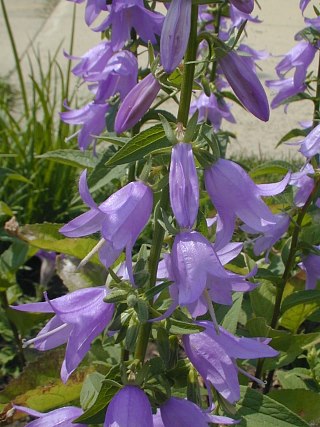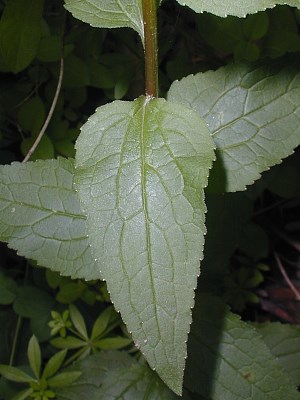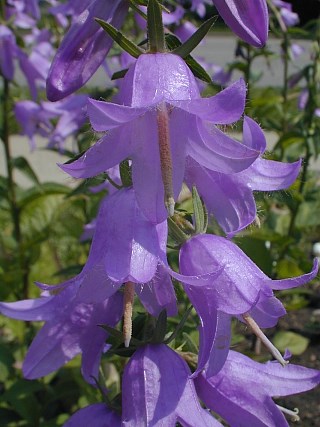Description: This herbaceous perennial plant is 1½–3' tall and little branched. The central stem is light green to reddish brown, glabrous to slightly hairy, and terete or angular. The alternate leaves are up to 5" long, 2" across, and variable in shape; the lowest leaves are often cordate-oval, while the middle and upper leaves are ovate-lanceolate to lanceolate. All of these leaves have crenate or serrated margins; their upper surfaces are medium to dark green, while their lower surfaces are light green and short-hairy along the veins. The lower and middle leaves have slender petioles, while the upper leaves are more likely to be sessile. Sometimes short leafy stalks develop from the axils of the leaves on the central stem.

The central stem terminates in an elongated
raceme of flowers up to 1' long. The flowers tend to nod downward along
one side of the raceme on short pedicels. At the base of each pedicel,
there is a small leafy bract that is linear-lanceolate in shape.
Sometimes nodding flowers are produced from the axils of the upper
leaves on longer pedicels. Each flower has a bell-shaped blue-violet
corolla, 5 green sepals, 5 stamens, and an exerted style with 3 curled
stigmas. The corolla is 1–1½" long and half as much across; it has 5
pointed lobes that are recurved. The sepals are linear-lanceolate in
shape, widely spreading to recurved, and much smaller in size than the
corolla. The style is white or pale purple. The blooming period occurs
from mid-summer to early fall and lasts about a month. Each flower is
replaced by a globoid seed capsule that contains several small seeds.
The root system is rhizomatous. Occasionally, small colonies of plants
are produced from the long rhizomes.
Cultivation:
The preference is full to partial sun, more or less mesic conditions,
and a fertile loamy soil.

Range &
Habitat:
Creeping Bellflower naturalizes occasionally in northern Illinois and
uncommonly in central Illinois; it is apparently rare or absent in
southern Illinois (see Distribution
Map). This species was introduced into North America from
Europe as an
ornamental plant. Habitats include open woodlands, savannas, thickets,
fence rows, edges of yards, roadsides, and waste areas. Creeping
Bellflower is often cultivated in gardens because of its showy flowers.
Faunal Associations:
According to Müller (1873/1883), the flowers of Creeping Bellflower
produce both nectar and pollen. Müller observed honeybees, bumblebees,
Halictid bees, and other bees visiting the flowers for nectar or pollen
in Germany; he also observed a Syrphid fly with a long proboscis (Rhingia
sp.) sucking nectar from the flowers. Aside from these
observations, further information about floral-faunal relationships for
this species are unavailable.

Photographic
Location:
The photographs were taken at a flower garden in Urbana,
Illinois.
Comments:
Creeping Bellflower has very showy flowers. Among the Eurasian
bellflowers that are cultivated, this is the species that most often
escapes — in part because it is more commonly cultivated. A species
that has naturalized less often in Illinois, Campanula
glomerata (Clustered Bellflower), has more erect flowers that
are clustered together at the apex each central stem. The flowers of
this species have sepals that are longer and wider than those of
Creeping Bellflower. The circumboreal Campanula rotundifolia
(Harebells) and native Campanulastrum americanum
(American Bellflower) are quite distinct from Creeping Bellflower.
Harebells has linear leaves along its stems and its bell-shaped flowers
are smaller in size (usually less than 1" in length) than those of
creeping Bellflower. The flowers of American Bellflower have shallow
corollas that are star-shaped with widely spreading lobes; the older
scientific name of this latter species is Campanula americana.